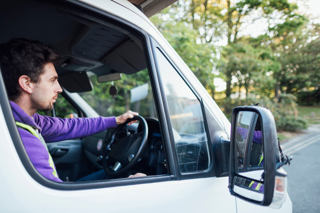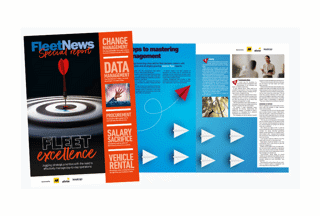Drivers were put at the heart of the decision-making process when NHS Blood and Transplant wanted to determine a national specification for its vehicles.
The organisation created a vehicle working group, including driver representatives, to determine clear, fit-for-purpose standards.
Fifteen years later, the group’s work has proved so successful that little change has had to be made.
“Because we feel we managed that process so well and the involvement with our drivers was so good, we now only have to tweak the specification as we go along,” says Larry Bannon, fleet manager at NHS Blood and Transplant.
“We have about 12 different specifications on our fleet and we tend to meet only once every two years or something like that when it’s time to look at making changes to a certain specification.”
This process also improved the relationship between drivers and the fleet department, as well as making it easier to achieve buy-in for changes.
“Having the working group means we are addressing one of the values of our organisation in that we want to encourage the involvement and inclusivity of everybody in the decision-making process,” says Bannon.
Use feedback to reinforce decisions
“Another benefit is that when we look to implement an element that’s different to the usual specification, its implementation goes a lot more smoothly because driver representatives who have been able to feed into that change have also been able to feed back to the workforce.
“We have 300 drivers and a turnover of 10%, so we have 30-odd drivers who join us every year.
“New drivers will come in and ask ‘why are we doing that?’, and when we tell them it’s because that aspect has been developed in collaboration with drivers it becomes easier to sell that to them.
“If we didn’t have these groups, and initiatives were just being imposed by the fleet department, then the challenge from the drivers will be ‘well, you don’t drive these vehicles, you don’t know what we do on a daily basis’.”
Initiatives like this highlight how important it can be to involve drivers in policy changes that affect them: NHS Blood and Transplant is not alone in using driver feedback in this way.
Get drivers involved in vehicle specification
British Gas has vehicle user groups to define each vehicle and racking specification, and actively communicates total cost of ownership so engineers understand the procurement processes.
Catering industry kitchen appliance provider Hobart UK last year sought the opinions of engineers at its annual roadshow and their feedback led to a change in vehicle racking design to make their jobs easier.
“Drivers are a fleet manager’s eyes and ears on the road,” says Geoffrey Bray, chairman of the Fleet Industry Advisory Group.
“Fleet decision-makers that fail to involve drivers in the decision-making process cannot possibly know what the day-to-day operational impact of any decisions may be.”
It is the drivers’ extensive first-hand experience of vehicles and processes which makes it vital not to underestimate the importance of their feedback.
“In our opinion, the drivers’ views are just as important as those of other stakeholders such as HR, finance and senior management,” says Peter Eldridge, director of the Institute of Car Fleet Management.
“Consultation should take place before and during the development of a policy and fleet managers should gain user feedback on a regular basis.”
Driver communication can improve vehicle maintenance
John Pryor, chairman of fleet operators’ association ACFO, says fleets should seek driver engagement not just when determining the specification of new vehicles, but throughout a car or van’s life, including when it requires maintenance.
“If poor service is delivered by a garage it may be that the fleet manager and therefore the business is left in the dark unless driver engagement and communication is encouraged,” he says.
“Ensuring top class service, maintenance and repair is received can help improve business efficiency.”
Bray adds: “In terms of the way a vehicle performs in life and interaction with frontline suppliers such as fleet management companies and repair garages, drivers’ views should be actively obtained and taken into consideration when reviewing and potential changing policies.”
The ICFM feels that having a dedicated stakeholder team with driver representation is critical.
“That team could be two people but it could be 20 people, it depends on the size and complexity of the business, but we believe that is absolutely vital,” says Eldridge.
Always welcome feedback
Bray says it may not be possible to engage individually with each driver in a large organisation, but agrees that one way to improve two-way communication would be to form drivers’ representative groups.
“All employees should feel that they can at least communicate by telephone or email with the fleet manager and their views will, at the very least, be listened to,” he adds.
Bannon has found that embracing driver involvement has helped produce a relationship where employees are comfortable offering suggestions away from the vehicle working group structure.
One recent example was when a driver pointed out that the illuminated button inside a vehicle’s cabin which operates the blue lights was too bright.
“It was a distraction, particularly when it was dark outside, so it was a case of looking at what illumination was in there and putting it right,” says Bannon.
“Little things like that can irritate so we try to address them. The vehicles are our drivers’ offices as they are in there every day: if there was something in my office irritating me, I’d do something about it.
“Our relationship with the drivers has enabled that one-off type feedback instead of having to wait for a meeting.”
Case study: Miller's Vanguard
Food industry machinery supplier and engineer Miller’s Vanguard has implemented a number of changes after seeking driver feedback.
Fleet manager Nick Webb says one example of this came after the company received a new batch of vans.
“When we originally took on our vehicles, they had racking in them,” he says.
“They had three shelves, and the historical lighting from manufacturers is a light in the roof which illuminated the top shelf, yet in the dark it doesn’t light the bottom two.
“One of our engineers came to me and asked if we could do something about it.”
Webb met the engineer and they redesigned the lighting system, with the improved illumination now standard in all of the company’s vehicles.
“When the side or back door is now opened, the cargo area is all lit up,” says Webb. “I then told all the guys that the reason they’ve got the new lighting was because of Jason’s idea.
“Communication has to be two ways. If the drivers want to, they can contact Jason directly and tell him what a great idea it was and they know that, as a business, we value their opinion.”
Webb says the company also supplies all vans with spare light bulb kits following feedback from a driver.
“All drivers have to perform daily vehicle checks and one of the guys asked what they do if a bulb is out,” he says.
“He made the point that if we expected him to drive to buy a new bulb that we were asking him to drive illegally, so we bought spare bulb kits.
“We sent them out to the drivers at the same time as a tyre tread gauge, because if you want them to check the tyres, you need to give them the equipment to do it.”



















Login to comment
Comments
No comments have been made yet.